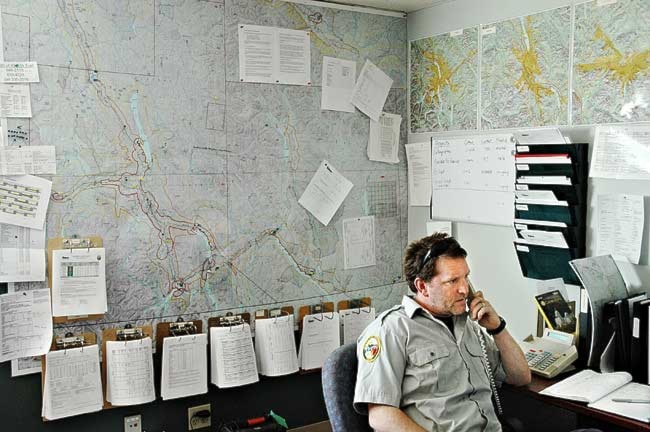At the Whitehorse firebase, things were “hoppin.”
A wildfire in BC was picking up, duty officer Chris Stuart’s phone was ringing off the hook and the morning weather briefing was about to get underway.
This was the most excitement the crew would see all day.
Fire conditions were “continuous crown.” Lightening was on it way over from the Northwest Territories.
Then Stuart got the Haeckel Hill fire tower on the line, along with crews in Carcross and Teslin.
They talked “fire/fuel ratios,” and “moisture content.”
And that was it.
The five local crew members, most wearing “Initial Attack” T-shirts, walked back downstairs to the kitchen and had coffee, bagels and cream cheese and some granola bars.
When they’re on a fire, each guy needs upwards of 4,000 calories a day and more than a litre of water an hour.
But today, like most days, there’s only the threat of fire.
So, instead of hauling 60-pound hose packs, chainsaws and pump kits into the burning bush, the crew put on 40-pound vests with weighted pockets and walked through the airport parking lot to the Beringia Centre and back.
Every morning the crew does one hour of physical training, either mountain biking, running the Black Street stairs or walking with the pack vests.
The crew used to play ball hockey, but it was banned after one guy blew out an ankle, making him useless on the fireline.
Walking back to Hangar D, a squat tin building beside the airport that acts as Whitehorse fire headquarters, Howard Johnstone admitted the job can get “boring.”
It’s 95 per cent training and five per cent fighting actual fires, he says.
But when they’re on a fire, they risk everything.
“I think most firefighters have nine lives,” he says.
Johnstone’s down to his last two.
It’s a dangerous job, but when Johnstone talks about the risks, forest fires are not the first thing he mentions.
Instead, he talks about helicopters.
“Things can go bad real fast in a helicopter,” he says.
“I’ve seen people walk off the job after seeing a helicopter crash - and I jump in, thinking what are the chances of it happening twice.”
Today, the crews don’t have a chopper at the base. It was called down to Watson Lake.
Crew member Steve Morberg walks over to a pallet of pumps, hoses, chainsaws, a first aid kit and water.
It’s the equipment that gets loaded on the helicopter when they get the call.
It’s Morberg’s job to go through it, using a checklist.
He picks up a slender piece of clear tubing.
“Forgetting this is a very expensive mistake,” he says. It’s the fuel line for the pump.
The gear is checked every day.
So is the fire truck, an urban interface unit that can handle dirt roads and city needs.
Most of the fires around here are caused by people who’ve driven somewhere, says crew member Dale Van Damme. So they’re usually accessible by road.
The guys played with the spray hose on the front of the truck, controlled by a joystick in the cab.
Then, they set up sprinklers and test them, accidentally spraying a few private planes sitting just off the airport runway.
That’s the morning.
The afternoon is even slower.
“On days like this, we just sit around, drink water and wait for a fire,” says Johnstone.
When it’s slow in the Yukon, crews are often shipped out to other parts of Canada.
And when things get hot here, the territory brings in crews from Outside, called “exports.”
It can be scary working with strangers, especially when your life’s on the line, says Johnstone.
He’s been working the job for 13 years, and never lost a friend on a fire.
“But I know one could,” he says.
On a fire there’s so much adrenaline, says Johnstone.
Crews work around the clock building fireline, drop to the ground for a few hours sleep and then are up and at it again.
But between fires, the waiting around can be tiring.
On this sunny afternoon, some of the guys bring out folding chairs and sit outside.
One guy runs a hose to the water truck, to top it up.
And that is their day.
Contact Genesee Keevil at
gkeevil@yukon-news.com
